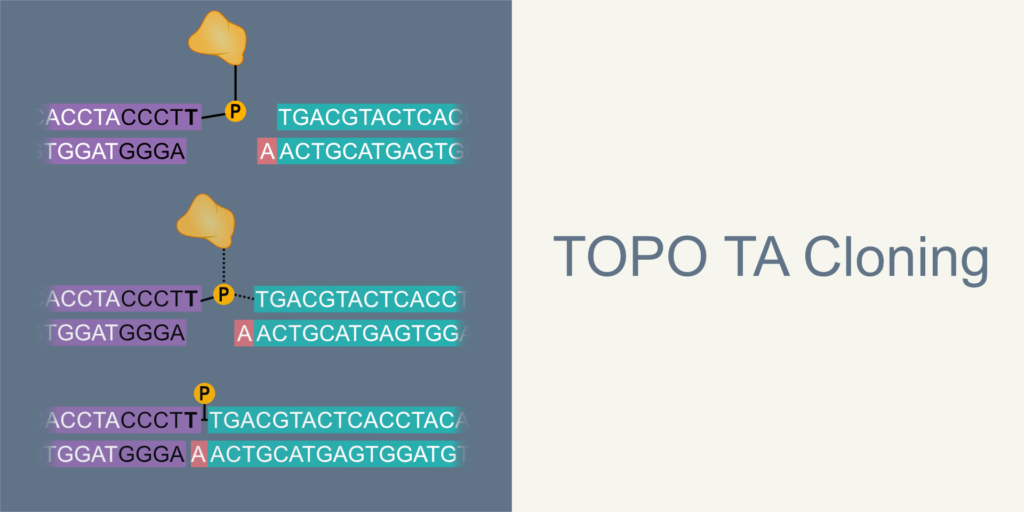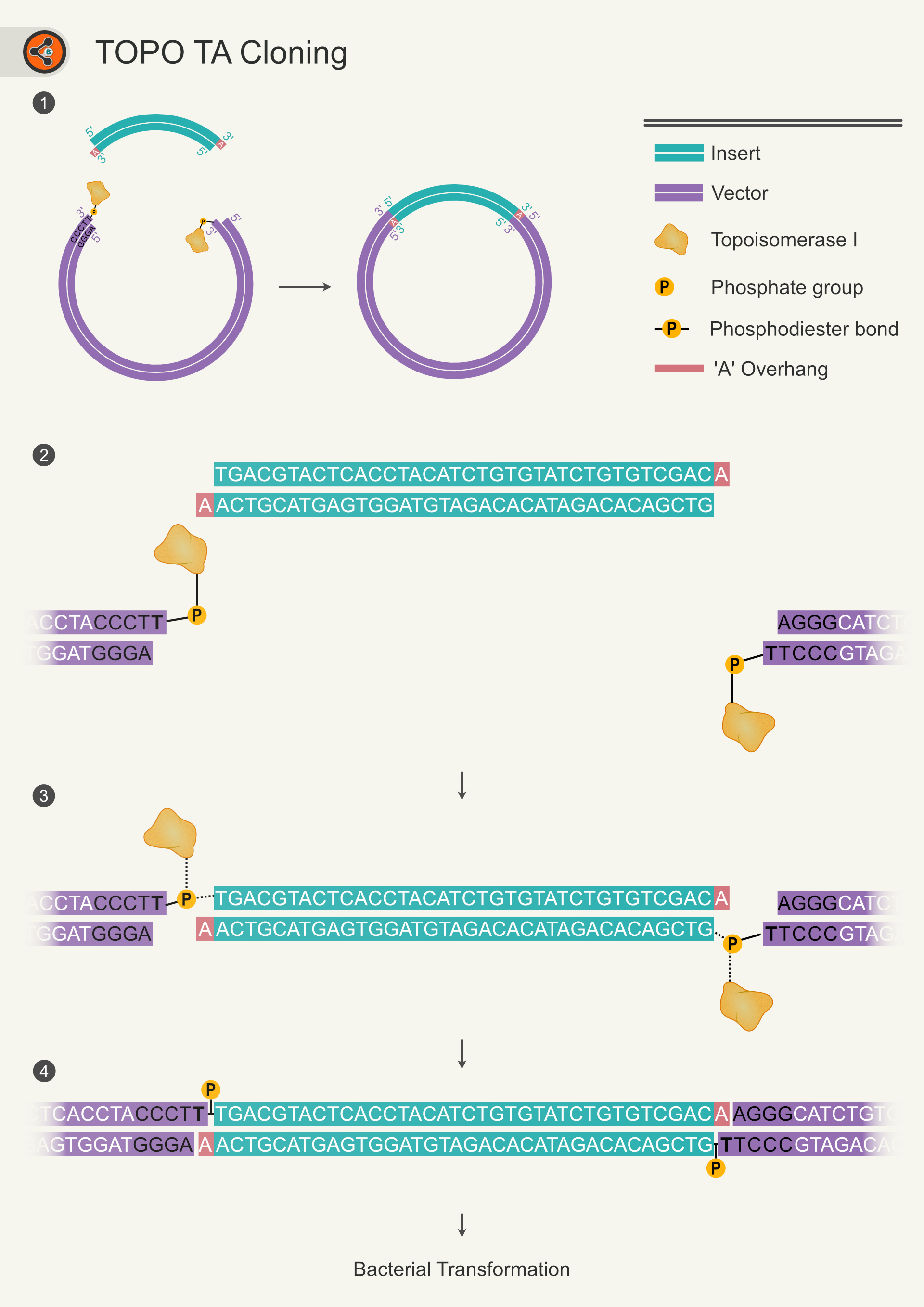TOPO TA Cloning

Introduction
TA cloning is a simple method to clone any desirable fragment with an extra A (Adenine nucleotide) overhang into any linearized vector with T (Thymidine nucleotide) overhang.
TOPO TA cloning is restriction digestion-free and ligation-free cloning. Tradition TA cloning method requires ligation step to seal the joints of the vector with insert. The first successful TA cloning method was developed by T.A. Haloton in 1990 to directly clone the PCR amplified products compared to conventional cloning. The ligation step was skipped in TOPO TA cloning by using the topoisomerase 1 enzyme. In 1987 Shuman and Moss identified the DNA topoisomerase 1 from the vaccinia virus. The topoisomerase relaxes the super-coiled DNA by unwinding or winding duplex DNA by cutting and rejoining during replication and transcription.
The topoisomerase I from the Vaccinia virus recognizes the pentapyrimidine element 5’-C/TCCTT-3′ sequence and cuts the DNA (Shuman et al. 1991, 1992). The ability of the topoisomerase enzyme to recognize specific DNA sequence, cutting within the recognition sequence, and rejoin was utilized in TOPO cloning.
In the cleavage reaction, topoisomerase is attached to the 3’end by forming a covalent bond between cleaved 3′ DNA strands to topoisomerase’s tyrosine residue (Tyr274). The energy stored in this phospho-tyrosyl bond between the DNA and enzyme is utilized to religate the ends that originally cleaved or religate to a heterologous acceptor DNA (Insert). The enzyme gets released from vector ends after rejoining the ends. In 1994 Shuman used this topoisomerase 1 from the vaccinia virus enzyme to make recombinant plasmid.
Principle
DNA topoisomerase enzyme has sequence-specific DNA cleavage and ligation activity. In TOPO TA cloning, the T overhang containing vector ends are attached with the TOPO enzyme. The topoisomerase enzyme seals the joints during the stable association of the vector and insert ends using AT base-pairing.

Figure 1. Schematic diagram representing steps in TOPO TA cloning. 1.1 An overview of TOPO TA cloning. Insert (teal) is ligated with vector (violet) resulting in recombinant vector (final product). 1.2-1.4 Shows the steps involved in the ligation during topo cloning. 1.2 Shows the insert with ‘A’ overhangs ligates to linearized ‘T’ overhang vector. The ‘T’ overhang is from a piece of DNA sequence (5’C/TCCTT-3′) recognizes by vaccinia virus topoisomerase I 1.3 The 5′ OH of inset grabs phosphate group via nucleophilic substitution and replaces topoisomerase I with itself. 1.4 After successful TOPO reaction, insert attached with the vector backbone with two phosphodiester bonds in total. This arrangement leaves nicks that would be sealed in the bacteria after transformation.
Advantages
- Restriction-free and ligation-free cloning
- It is easy to use, and a simple cloning technique is generally used for subcloning.
- It is efficient compared to Blunt end cloning and regular TA cloning as there is no need to use ligase enzyme.
- The simple design of primers (without any extra bases at the 5′ end of primer)
Limitations
- Non-directional cloning generates inserts only 50% in the proper orientation.
- Dependency on the vendors for TOPO blunt vectors; it will be challenging to create vectors in the lab.
- Compared with blunt-end cloning, the insert requires additional ‘A’ tailing which requires extra steps. Although the Taq polymerase can be used for amplification to bypasses this step, it is not advisable as it may create mutations.
Procedure – an overview
TOPO TA cloning involves the following steps.
- Preparation of Insert
- Selection of vector
- TOPO cloning reaction
- Transformation
- Selection of transformants and other downstream processes.
Let us see the first three steps.
Preparation of Insert
The detailed description of A overhang containing insert preparation is discussed here. Successful ‘A’ tailing depends on the nucleotide sequence present at the insert ends. For a better prediction of efficiency please read the article mentioned above.
In brief, there are two ways to generate A-overhang containing inserts.
- If the PCR product is amplified using NON-proof reading polymerase (Example Taq polymerase) generates PCR products with 3′ A overhang. The downside is that it may cause mutations.
- The PCR products are amplified using the Proofreading polymerase (example -Pfu polymerase) with 3′ to 5′ exonuclease activity, which generates blunt end products. Incubation of this purified Blunt end PCR product with regular Taq polymerase in the presence of dATP adds A overhang.
Primer design: TOPO TA cloning primers do not require any special sequences or modifications. A detailed demonstration of primer designing is mentioned here.
Vector
The vector needs to be purchased from the vendor. Vectors are available with different feature sets that aids in downstream processes. Please choose a suitable vector as per your needs.
TOPO Reaction
Mix the A overhang containing insert with TOPO TA reaction mixture, which contains pCR TOPO vector. Incubate the reaction sample at 25°C for 15 min and proceed with transformation.
Transformation
Detailed protocol for transformation is discussed here.
